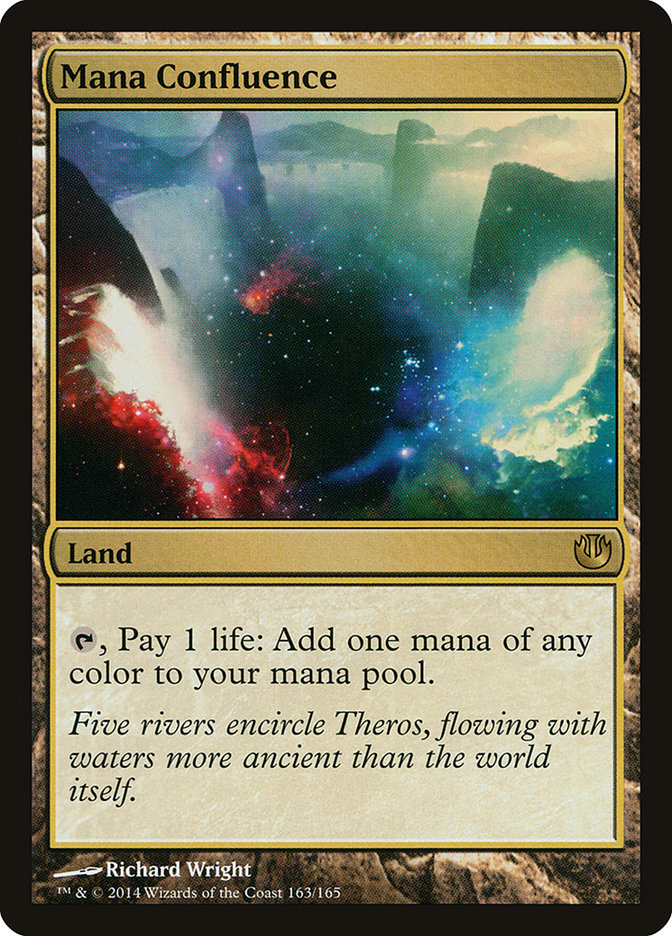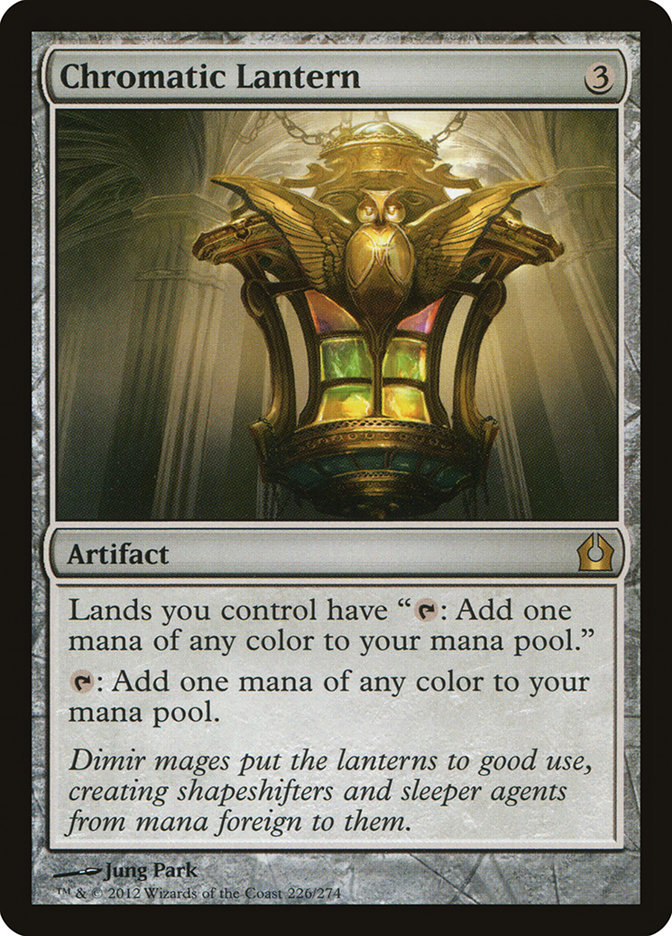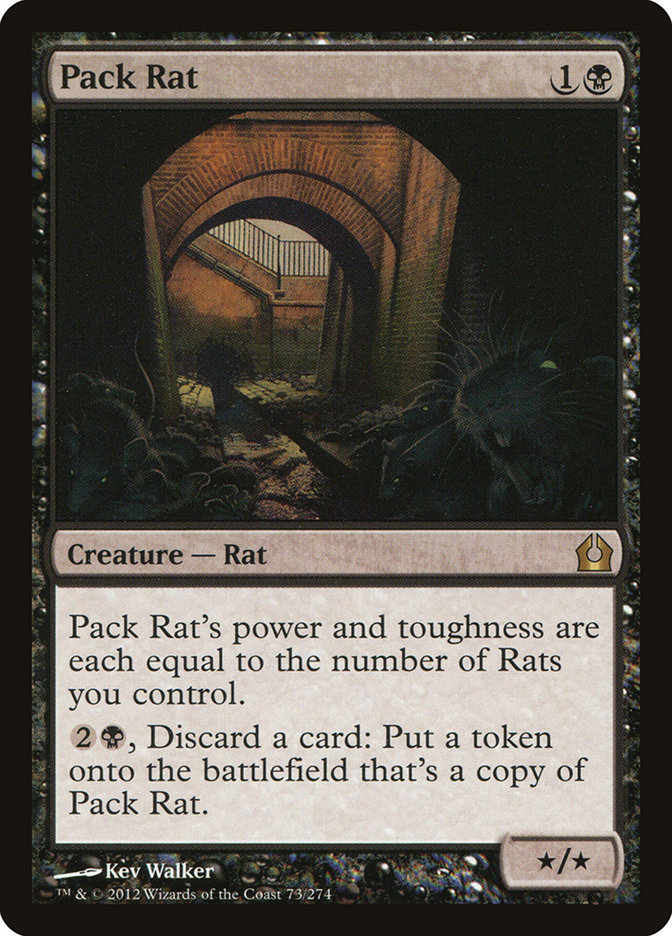Out of all the cards Journey into Nyx brought us, Mana Confluence is undoubtedly the most debated.
Some suggested that it would be a mainstay of two-color aggro decks who could not directly upgrade their land bases by shaving off or completely removing
Temples. Others posited that it would provide consistency for those three-color midrange decks waiting in the wings for something to combat the reliability
and power of Esper in the control category.
But what about using it as a way to make five-color decks? Would those kinds of decks get help from a shock land that taps for more than just two types of
mana? You bet they would!
Nothing represents five-color attempts in Standard better than Chromanticore, the awkward, five-color bestow creature with an ability from every color.
This strange enchantment Baneslayer Angel is a very powerful combat creature at five mana and an attractive bestow target itself. Coming up with the
support has been the tricky part. Ever since Chromanticore was spoiled in February, brewers around the world have been trying to wrangle this bizarre
five-color Akroma, Angel of Wrath into a Standard deck, looking to make the deck consistent enough to spit out the Manticore on time.
The multicolored nature of Ravnica Block brought us several tools that help ease the cost of a Chromanticore, and one artifact highlights this perfectly.
When you combine Chromatic Lantern with Mana Confluence, the interaction seems redundant. But if you look closely, Chromatic Lantern adds a mana ability to
every land you control. While Mana Confluence’s innate ability requires that you pay a life to use it, adding Chromatic Lantern gives you an additional
ability to tap it that doesn’t cost life. Don’t worry, this isn’t revolutionary; every other Chromanticore deck has tried it, too.
What I propose, however, is a firmly colored base. One color could provide the jumping off point for normal, consistent spells. Then, after resolving a
Lantern, I’d be free to cast anything and everything I wanted. I looked at each of the five colors as a potential candidate. Maybe green, with its ramp,
color fixing, and powerful creatures would fit the bill. I used green as a base for my five-color Nephilim deck in Ravnica Standard, after all, with Orochi
Leafcaller as my enabler. Blue could do it; its heavy counterspell and bounce base could provide the perfect platform.
In the end, though, black won out. Thoughtseize, Hero’s Downfall, and Pack Rat all proved best in class, and it was quickly decided the base would be
Swamps. From there, I was interested in using Mana Confluences to splash into other colors while I waited to draw a Lantern. The base would, thus, share
several similarities with mono-black devotion, a tried and true deck. In fact, at first, it might look exactly like MBD. That’s when you cast an
off-color monster that completely shocks them.
Here’s a start.
Creatures (8)
Planeswalkers (4)
Lands (25)
Spells (23)

As is the case with control decks, this looks pretty unwieldy at first. The plan is to evolve your board and hand based on Mono-Black’s tried and true
shell. Instead of Gray Merchant of Asphodel, though, you’re casting a five-color bruiser. Is it soft to removal? Yes. Is it still unable to beat an X/5?
Not really. Will you have a deck to back it up and help you push through damage anyway? You betcha.
Creatures
Only eight creatures fill the ranks, four of which are our trusty Manticore. The other four are very purposefully chosen: Pack Rat.
This little menace has terrorized both RTR Block and Standard for months, and although it seems out of place in a five-color deck, Pack Rat offers you
something few five-color decks can effectively provide: consistency. If you have an off-color card or a clumsy, expensive spell, you can toss it and make
it a relevant Rat anytime you want. Because the black base of this deck provides most of the color, you’ll always have that option with three mana up.
There are also several cards in this deck that become worse with extra copies, such as Chromatic Lantern and Mana Confluence. Having access to such a
simple card helps a deck like this survive in the real world. You’re not worried about devotion or even amassing several Rats at all; sometimes you just
need blockers, and you can respond according to the deck you’re playing. Are they on U/W? Maybe lay off the activation to avoid Detention Sphere or Supreme
Verdict. If they’re on the Monsters plan, though, feel free to churn them out! Moreover, making Rats provides you a steady source of targets for your
Chromanticore bestow. Chromanticore is fine by itself, but it’s pretty fun to make a little 3/3 Rat a very angry, flying, first-striking, and trampling 7/7
Rat.
Spells
Chromatic Lantern as a playset might seem excessive, but resolving Chromanticore utterly depends on it, and you can always discard the extra copies to Pack
Rat. I like that you’re able to cast the Lantern and Thoughtseize with it, for whatever that’s worth. From there, many of the spells are mostly familiar to
anyone who’s played or seen Mono-Black Devotion (read: everybody.) A set of Seizes, Hero’s Downfall and a trio of Devour Flesh are industry standard, and a
couple of Underworld Connections make their way in, too. The devotion aspect is less relevant with Connections this time; you just want to draw more cards.
That’s where the similarities end. Several B/X spells exist beyond this point, including Rakdos’s Return and Abrupt Decay, providing useful effects for a
deck that demands diversity in its threats and answers. Planeswalkers flesh out the rest of the deck, included two completely off-color choices. Kiora, the
Crashing Wave will only get better with time, in my opinion. Her ability to stop a threat as Tamiyo, the Moon Sage does is always good, and her ability to
ramp and draw cards means Rakdos’s Return, Chromanticores will come out that much more quickly. Liliana of the Dark Realms can search up a Swamp and Kiora
can use her Explore effect to let you play it right away!
Ajani, Mentor of Heroes is a trial member of the team; his second +1 ability is less synergetic, getting only thirteen targets mainboard, but his first
ability might just let you punch through a stalemate. Pumping Chromanticore means you’re gaining more life with every hit. Vraska the Unseen is one of my
favorite cards to resolve on time, especially if you can +1 her right away, letting her store up two removal spells for the next couple turns. Sphinx’s
Revelation comes way out of left field; one Chromatic Lantern and you can draw a fresh new grip of sweet removal, Planeswalkers, and Pack Rat fodder.
Lands
Because of the Lantern, the deck can afford a full set of Mutavaults; moreover, Mutavault pairs well with Pack Rat, as we’ve all seen, and it lets you take
over a stalemate. For each color, you’ll also find the corresponding Swamp shock land. Liliana of the Dark Realms can go fetch them as needed.
Sideboard
From the sideboard, a variety of spells can completely change your approach to your opponent’s deck. The most plentiful card, Blood Baron of Vizkopa, is an
ace in the hole against either color’s deck. Devour Flesh remains the only way Mono-Black Devotion can kill a resolved Blood Baron, and white decks can’t
target it with Reprisal, Banishing Light, or Banishing Priest. Frankly, Blood Baron of Vizkopa is a more relevant, harder-to-kill Chromanticore, but that
defeats the purpose!
Slaughter Games seems on-target here, perhaps as a Game 3 sideboard option. Short of Thoughtseize, this will resolve if you draw it, so it’s a nice,
reliable way to pluck the Sphinx’s Revelation, Gray Merchant of Asphodel, or Obzedat, Ghost Council right out of their decks. Detention Sphere access for a
mono-black deck lets them handle anything they otherwise couldn’t, and Doom Blade comes in against fast green decks. The other singletons answer specific
problems, each of which should be fairly apparent.
This deck provides the opportunity for Mono-Black to cast every spell, diversifying its win conditions across every color of the wheel. If you have the
core of Mono-Black plus a handful of Standard singletons, you might be able to flesh this one out and try it yourself. It’s a deck that does all the things
Standard can do while being consistent and sturdy enough to appeal to more competition-focused players. Besides, whether Spike or Timmy, everyone
loves to cast a 4/4 flying, first strike, vigilant, trample, lifelink Manticore for WUBRG.
Mana Confluence has been considered by some as a replacement in Eternal formats for City of Brass because it can be safely tapped without damaging its
controller (à la Pestermite and Rishadan Port). For me, it gives another no-strings-attached prismatic land to create deeper and deeper combo potential in
Modern. We could probably do something awesome with it, right?
Depends on your definition.
One of my good friends in college, Tom, was a Zubera fiend. He always built the five-color deck in our group, whether it was constructed or Limited, he’d
always find a way to shuffle up all five basic lands types each time we played. His pet deck, the deck for which he was known, revolved around the
one-and-done creature type Zuberas. Zuberas, of which there are only seven in the history of Magic, were Spirit creatures that cared about when and how
they died. Tom’s plan was to resolve as much of these little critters as he could then cast Devouring Greed. All of his effects would trigger and one of us
would die a horrible, greedy death, and the rest of us would discard our hands or get charred to a crisp. Tom wanted to spread the love.
There are five two-drop Zuberas, all with a similar effect, and the emergence of Mana Confluence gave me an idea…
Creatures (32)
- 4 Silent-Chant Zubera
- 4 Floating-Dream Zubera
- 4 Ember-Fist Zubera
- 4 Dripping-Tongue Zubera
- 4 Ashen-Skin Zubera
- 4 Wild Cantor
- 4 Viscera Seer
- 4 Burning-Tree Emissary
Lands (19)
Spells (9)
Sideboard

The goal is to use Beck // Call to generate a chain of Zubera that, when sacrificed, yield a highly desirable result, whether it’s a handful of cards in
your hand, stripping your opponent of their hand, or dealing damage to their creatures and/or face. All of the Zuberas’ triggered abilities are fairly
reasonable, but when you put them together, they become truly formidable.
Naturally, every slot is filled with the five cheap Zuberas. The two more expensive ones are abysmal, but you want as many Zuberas as you can fit, so these
form the base. From there, Wild Cantor allows you to set up the combo. Wild Cantor has three uses. First, it ramps. This and a land on two let you cast one
of the reduction spells that we’ll talk about in a second. Second, it fixes color for free. This provides you one mana on demand that requires a very cheap
investment. Even if you use it the same turn you cast it, you’re still netting zero. Finally, it is a free spell while Beck // Call is active. Cast it,
draw a card, then sacrifice it to replace its mana cost. Burning-Tree Emissary only fulfills this final function, but she does so while also not slowing
you down the turn you cast her. Viscera Seer is our sacrifice outlet, and the scrying function lets you dig for the necessary Beck // Call or Zubera needed
to seal the deal.
The spell list is quite short. Beck // Call, which sadly must stand in for the banned Glimpse of Nature, acts as the engine to draw into more and more
Zuberas. The two combo enhancers, Heartbeat of Spring and Cloud Key, cut the cost of each Zubera in half, letting you jam more of them in on the crucial
turn. The Spellbook seems out of place, but if you sacrifice Floating-Dream Zubera amongst your others, your hand will be overflowing. Add a Spellbook to
the board to give yourself the option to hold a handful of Zuberas for the next turn. It’s a bit of a longshot, sure, but this deck will rarely go off all
at once, so you’ll need to be prepared. Reliquary Tower, while taking up an essential land drop, doesn’t actually provide much meaningful mana, especially
if Cloud Key is out.
The land is all prismatic; every land, in one circumstance or another, can produce every color, and none of them come into play tapped. City of Brass and
Mana Confluence are nearly analogous here, and Gemstone Mine and Forbidden Orchard both provide provisional color. Cavern of Souls provides the ability to
cast any Zubera, but it can also be played on Human so that you can cast either Wild Cantor or Burning-Tree Emissary on time.
The sideboard is a rough draft, but it’s filled with almost all creatures. Nature’s Claim is still terribly efficient, and Spellskite prevents a surprising
amount of shenanigans from occurring. Tin Street Hooligan is an on-curve answer for the artifact-heavy decks you might encounter. Cast it off Burning-Tree
Emissary for maximum effect! Adaptive Automaton sees play over Long-Forgotten Gohei, Kamigawa Block’s favorite Spirit anthem effect. Because the Automaton becomes a Zubera, it will be counted as part of the resolution of any other Zubera’s death effects. If a 1/2 isn’t enough to break through your
opponents’ lines (when would it be?), slot the Automaton in for the most irrelevant Zubera or the Emissary, which is already Beck // Call fodder.
Have you crafted up some bizarre five-color brew in Standard or Modern thanks to the addition of Mana Confluence? What decks does it make easier for you?




